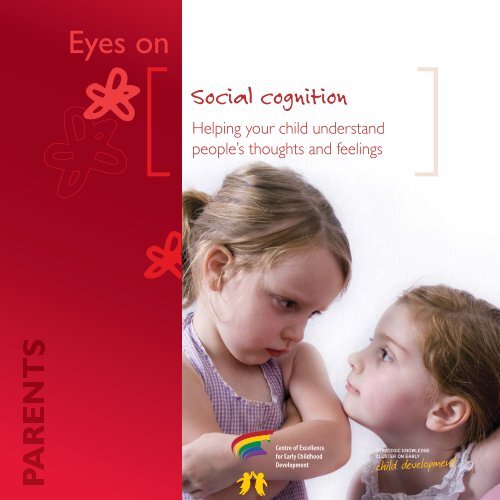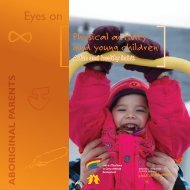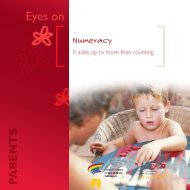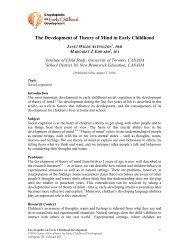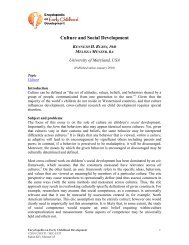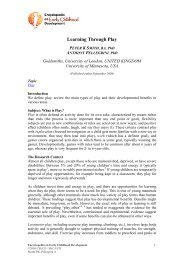Eyes on Social cognition: Helping your child understand people's ...
Eyes on Social cognition: Helping your child understand people's ...
Eyes on Social cognition: Helping your child understand people's ...
Create successful ePaper yourself
Turn your PDF publications into a flip-book with our unique Google optimized e-Paper software.
<str<strong>on</strong>g>Eyes</str<strong>on</strong>g> <strong>on</strong><br />
<strong>Social</strong> cogniti<strong>on</strong><br />
<strong>Helping</strong> <strong>your</strong> <strong>child</strong> <strong>understand</strong><br />
people’s thoughts and feelings
<strong>Social</strong> cogniti<strong>on</strong><br />
“Children who<br />
develop social<br />
cogniti<strong>on</strong> at a<br />
young age have<br />
the foundati<strong>on</strong>s<br />
for good social<br />
interacti<strong>on</strong>s before<br />
they start school.”<br />
© 2011 – Centre of Excellence for Early Childhood Development<br />
What do we know?<br />
■ “<strong>Social</strong> cogniti<strong>on</strong>” means being able to <strong>understand</strong> our own and others’ thoughts, desires, intenti<strong>on</strong>s,<br />
and feelings.<br />
■ Children begin to develop social skills when they <strong>understand</strong> how people’s thoughts, desires,<br />
intenti<strong>on</strong>s, and feelings affect the way they act and behave.<br />
■ Infants are born with an innate preference for social interacti<strong>on</strong>s. From birth, they pay the most<br />
attenti<strong>on</strong> to human faces and voices.<br />
■ In the first m<strong>on</strong>ths of life, infants are able to smile at people, and resp<strong>on</strong>d to others with gestures<br />
and facial expressi<strong>on</strong>s.<br />
■ By the end of the first year, infants start to share interest and attenti<strong>on</strong> in objects with you, and may<br />
decide whether or not to try a new activity based <strong>on</strong> <strong>your</strong> expressi<strong>on</strong>. For example, <strong>your</strong> infant may<br />
not play with a new toy if you appear anxious or worried.<br />
■ Around the age of two, toddlers distinguish a real object from a pretend object (ex. using a block as a<br />
teleph<strong>on</strong>e).<br />
■ As they grow older, <strong>child</strong>ren become able to talk about what they and other people like, want,<br />
think or know (around age 3). They also <strong>understand</strong> that people express different emoti<strong>on</strong>s<br />
depending <strong>on</strong> the situati<strong>on</strong> (ex. knowing that an individual is happy when he gets what he wants<br />
or sad if he does not).<br />
■ Four-year-old <strong>child</strong>ren usually recognize that other people’s thoughts may differ from their own.<br />
They no l<strong>on</strong>ger believe that every<strong>on</strong>e knows what they know. This step in their development helps<br />
them to <strong>understand</strong> that their own thoughts do not always reflect reality.<br />
■ Children who are able to c<strong>on</strong>trol impulsive thoughts and behaviours are better able to develop social<br />
cogniti<strong>on</strong>.<br />
■ Children who develop social cogniti<strong>on</strong> at a young age have the foundati<strong>on</strong>s for good social<br />
interacti<strong>on</strong>s before they start school.<br />
■ School-aged <strong>child</strong>ren with a well developed social cogniti<strong>on</strong> have a tendency to be better at resolving<br />
c<strong>on</strong>flicts with friends, which in turn can lead to more positive relati<strong>on</strong>ships with their peers. But<br />
equally these <strong>child</strong>ren may be better at decepti<strong>on</strong> and manipulati<strong>on</strong>.<br />
■ <strong>Social</strong> and cognitive <strong>understand</strong>ing can have a positive impact <strong>on</strong> <strong>child</strong>ren’s later school success.
<strong>Helping</strong> <strong>your</strong> <strong>child</strong> <strong>understand</strong> people’s thoughts and feelings<br />
Paying attenti<strong>on</strong> to... What can be d<strong>on</strong>e?<br />
...<strong>your</strong> <strong>child</strong>’s emoti<strong>on</strong>al expressi<strong>on</strong>.<br />
... <strong>your</strong> <strong>child</strong>’s ability to <strong>understand</strong><br />
goal-directed behaviours.<br />
... the distincti<strong>on</strong> <strong>your</strong> <strong>child</strong> makes between<br />
an object and thoughts about an object<br />
(i.e., mental representati<strong>on</strong>).<br />
... <strong>your</strong> <strong>child</strong>’s ability to take part in activities<br />
and to pay attenti<strong>on</strong> to what is happening.<br />
... experiences that help <strong>your</strong> <strong>child</strong> to<br />
develop early social and cognitive skills.<br />
... <strong>your</strong> <strong>child</strong>’s capacity to see things from<br />
other people’s points of view.<br />
... the importance of being a good model to<br />
<strong>your</strong> <strong>child</strong> to help him develop positive<br />
relati<strong>on</strong>ships.<br />
■ Recognize and name <strong>your</strong> <strong>child</strong>’s emoti<strong>on</strong>s. For example,<br />
“You seem sad that we have to leave the park.”<br />
■ Show <strong>your</strong> <strong>child</strong> new ways to obtain interesting outcomes. For<br />
example, manipulate toys in different ways than he naturally<br />
does.<br />
■ Create situati<strong>on</strong>s for pretend play. Show him that blocks can be<br />
used to represent other objects, such as a ph<strong>on</strong>e or a car.<br />
■ Join in <strong>your</strong> <strong>child</strong>’s play as a partner. For example, join in a game<br />
he is already playing and show interest. While playing together,<br />
ask him what he is doing and how he feels at the moment.<br />
■ Introduce <strong>your</strong> <strong>child</strong> to interactive activities with other<br />
<strong>child</strong>ren (ex. sand play or reading circle) that allow him to<br />
express his feelings, as well as experience the feelings and<br />
perspectives of others.<br />
■ During a group activity, take a moment to ask <strong>your</strong> <strong>child</strong> what<br />
he thinks his friends are thinking, feeling, and wanting.<br />
■ Invite <strong>your</strong> <strong>child</strong> to see things from different points of view. For<br />
example, when reading stories together, help him <strong>understand</strong><br />
why the characters act in certain ways.<br />
■ Be sensitive and caring with <strong>your</strong> <strong>child</strong>.<br />
■ Tell <strong>your</strong> <strong>child</strong> that it’s important to share, listen, and help when<br />
he’s playing with his brothers, sisters or friends.<br />
© 2011 – Centre of Excellence for Early Childhood Development
Coordinator:<br />
Mélanie Joly<br />
Collaborators:<br />
Isabelle Vinet (CPEQ)<br />
Claire Gasc<strong>on</strong> Giard<br />
Chris Moore<br />
Copy editors:<br />
Valérie Bell<br />
Lana Crossman<br />
Graphic design:<br />
DesJardins C<strong>on</strong>cepti<strong>on</strong> Graphique inc.<br />
Informati<strong>on</strong><br />
This Key Message is a publicati<strong>on</strong> of the Centre of Excellence for Early Childhood Development<br />
(CEECD) and the Strategic Knowledge Cluster <strong>on</strong> Early Child Development (SKC-ECD).<br />
These organizati<strong>on</strong>s identify and summarize the best scientific work <strong>on</strong> early <strong>child</strong>hood<br />
development. They disseminate this knowledge to a variety of audiences in formats and<br />
languages adapted to their needs.<br />
For a more in-depth <strong>understand</strong>ing of <strong>Social</strong> Cogniti<strong>on</strong>, c<strong>on</strong>sult our synthesis and Experts’<br />
articles <strong>on</strong> this topic in the Encyclopedia <strong>on</strong> Early Childhood Development, available free of<br />
charge at www.<strong>child</strong>-encyclopedia.com.<br />
Several funders financially support the CEECD and the SKC-ECD, including the <strong>Social</strong> Sciences<br />
and Humanities Research Council of Canada, Université Laval, and private foundati<strong>on</strong>s. The views<br />
expressed herein do not necessarily represent the official policies of these organizati<strong>on</strong>s.<br />
We are grateful to the F<strong>on</strong>dati<strong>on</strong> Lucie et André Chagn<strong>on</strong>, the Margaret & Wallace McCain<br />
Family Foundati<strong>on</strong> and the Alberta Centre for Child, Family and Community Research for their<br />
financial c<strong>on</strong>tributi<strong>on</strong>s to produce this Key Message.<br />
Centre of Excellence for Early Childhood Development<br />
GRIP-Université de M<strong>on</strong>tréal<br />
P.O. Box 6128, Succursale Centre-ville<br />
M<strong>on</strong>treal, Quebec H3C 3J7<br />
Teleph<strong>on</strong>e: 514.343.6111, extensi<strong>on</strong> 2541<br />
Fax: 514.343.6962<br />
E-mail: cedje-ceecd@um<strong>on</strong>treal.ca<br />
Website: www.excellence-early<strong>child</strong>hood.ca<br />
In this document, the masculine form is used to simplify the text. No discriminati<strong>on</strong> is intended.<br />
MC


